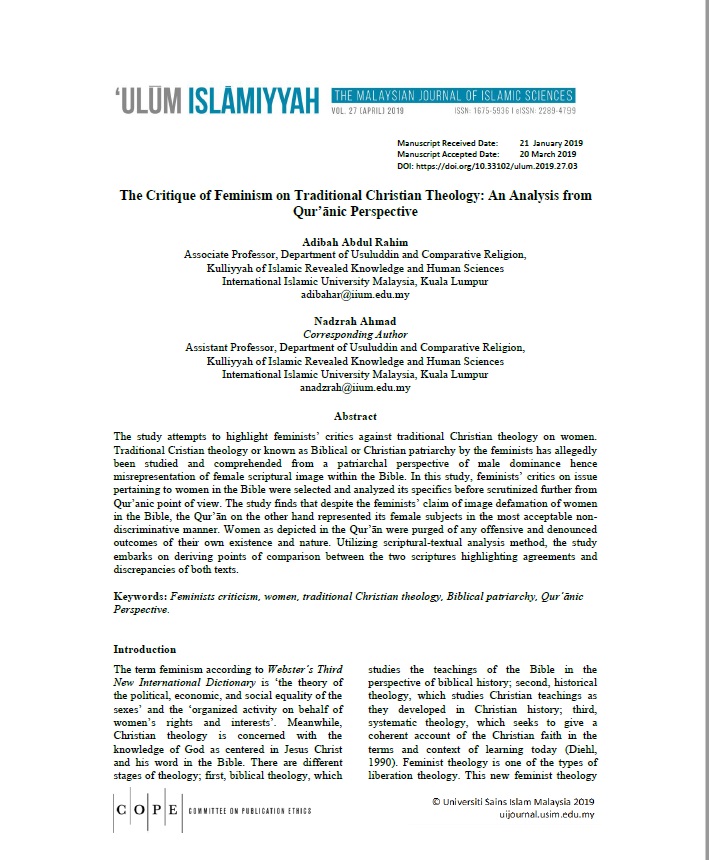The Critique of Feminism on Traditional Christian Theology: An Analysis from Qur’ānic Perspective
DOI:
https://doi.org/10.33102/uij.vol27no1.86Keywords:
Feminists criticism, women, traditional Christian theology, Biblical patriarchy, Quranic perspectiveAbstract
The study attempts to highlight feminists’ critics against traditional Christian theology on women. Traditional Cristian theology or known as Biblical or Christian patriarchy by the feminists has allegedly been studied and comprehended from a patriarchal perspective of male dominance hence misrepresentation of female scriptural image within the Bible. In this study, feminists’ critics on issue pertaining to women in the Bible were selected and analyzed its specifics before scrutinized further from Qur’anic point of view. The study finds that despite the feminists’ claim of image defamation of women in the Bible, the Qur’ān on the other hand represented its female subjects in the most acceptable non-discriminative manner. Women as depicted in the Qur’ān were purged of any offensive and denounced outcomes of their own existence and nature. Utilizing scriptural-textual analysis method, the study embarks on deriving points of comparison between the two scriptures highlighting agreements and discrepancies of both texts.
Downloads
References
Abdal Hakim Murad, “Islam, Irigaray, and the Retrieval of Gender,” Masud.Co.Uk, 1999, 1–18, http://www.masud.co.uk/ISLAM/ahm/gender.htm.
Alister E. Mc Grath. Christian Theology: An Introduction (Blackwell Publishers: Oxford UK and Cambridge USA, 1994)
Anne Mc Grew Bennet, “Overcoming the Biblical and Traditional Subordination to Women”, Feminist Theological Ethics, edited by Lois K. Daly ( Kentucky: Westminster John Knox Press, 1994)
Anne Mc Grew Bennet, From Women-Pain to Women-Vision: Writings in Feminist Theology, edited by Mary E. Hurt (Minneapolis: Fortress Press, 1989).
Daly, Mary Beyond God the Father: Toward a Philosophy of Women’s Liberation (Boston: Beacon, 1973).
Daly, Mary, The Church and the Second Sex ( New York: Harper and Row, 1968).
David W. Diehl, Jane Steffenson Hegen (editors), “Theology and Feminism”, Gender Matters: Women’s Studies for the Christian Community (Michigan: Academic Books, 1990)
Elizabeth Schussler Fiorenza, “A Feminist Theological reconstruction of Christian Origins: In Memory of Her (New York: 1994)
Georgina L Jardim, Recovering the Female Voice in Islamic Scripture : Women and Silence, 2014.
Luce Irigaray, An Ethics of Sexual Difference, trans. Burke, C., Gill, G. C., (New York: Cornell University Press, 1993)
Muhammad Saalih al-Munajjid. 2012. “There Were No Female Prophets or Messengers – Discussion of the Wisdom behind That.” IslamQA. https://islamqa.info/en/158044. (Accessed: 07/08/2017)
Murad, “Islam, Irigaray, and the Retrieval of Gender.”
O'Neill, Maura. Women speaking, women listening: Women in interreligious dialogue. Orbis Books, 1990.
Reconsidering Gender: Evangelical Perspectives, Ed. Myk Habets, Beulah Wood, USA: Pickwick Publications, 2011
Riffat Hassan, “Feminism in Islam,” Feminism and World Religions, 1999, 248–78, doi:10.1558/imre.vl7i3.349.
Rosemary Radford Rether, Scottish Journal of Theology: Is Feminism the End of Christianity? A Critique of Daphne Hampson of Theology and Feminism (Scotland: Scottish Journal of Theology Ltd, 1990)
Rosemary Radford Reuther, Sexism and God-Talk: Toward a Feminist Theology (Boston: Beacon Press, 1983).
Salih Karacabey, 2010, “Ulu'l-Azm Prophets and their Common Characteristics”, Last Prophet.info, http://www.lastprophet.info/ulul-azm-prophets-and-their-common-characteristics. (Accessed: 11/08/2017).
Stanton, Elizabeth Cady, The Women’s Bible, New York: Promotheus Books, 1999.
Sunnipath Academy Teacher, “Files and Resources Used for the Muslim Answers Sites Why Does the Qur’ān Refer to Allah with the Masculine Pronoun ?,” 2017, 7–9. https://muslimanswersfiles.wordpress.com/2013/05/01/why-does-the-Qur’ān-refer-to-allah-with-the-masculine-pronoun/. Retrieved 20/7/2017.

Downloads
Published
How to Cite
Issue
Section
License
Copyright (c) 2019 Adibah Abdul Rahim, Nadzrah Ahmad

This work is licensed under a Creative Commons Attribution-NonCommercial 4.0 International License.
If the article is accepted for publication, the copyright of this article will be vested to author(s) and granted the journal right of first publication with the work simultaneously licensed under the Creative Commons Attribution-NonCommercial 4.0 International License, unless otherwise stated. Anyone may reproduce, distribute, translate and create derivative works of this article (for both commercial and non-commercial purposes), subject to full attribution to the original publication and authors. The full terms of this licence may be seen at https://creativecommons.org/licenses/by-nc/4.0/.






